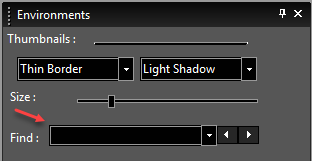Environments

Default UI Menu: Options/Environments
Ribbon UI Menu:

You can specify render options that affect the appearance of the background and foreground, as well as overall tone. These effects can be seen only when using Quality render. 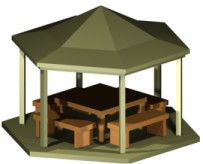
Quality rendered view with no Environment 
Render Scene Environment: Background = Clouds, Foreground = Snow Several environments and categories are provided by default. You can create a new environment via the Environments Editor
Loading and Saving Environments

Default UI Menu: Options/Environments/Load Environments, Options/Environments/Save Environments
Ribbon UI Menu:

Use the categories on the right side of the Save window to specify which environments you want to save. Environment data will be written to a .dat file, located in the RenderSceneEnv folder. Any new environment you define will be automatically saved in the TurboCAD file as well.To load an environment .dat file, select Load Environments from the Options / Environments menu, or from the local menu of the palette.
Managing Environments in the Render Manager

Default UI Menu: Options/Environments/Edit LightWorks Environments
Ribbon UI Menu:

Editing Environments can also be accessed from the Render Scene Environment page of the Drawing Setup. You can also access it from the Environments Palette; select the item in the palette, then right-click and select Edit Environments. Or double-right-click on the item, or click Edit Environments. 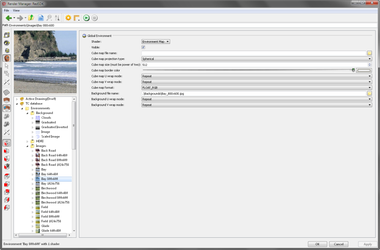
Right clicking on tree elements provides a variety of functions. Right clicking on Environments allows you to:
- Add Category
- Rebuild Thumbnails for all Environments
- Restore Default Environments
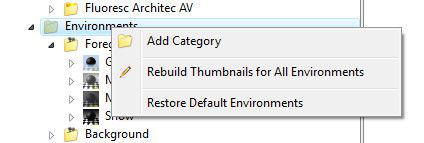 Right clicking on a Category allows you to:
Right clicking on a Category allows you to:
- Add SubCategory
- Delete Category
- New Environment
- Rebuild Thumbnails for all Category
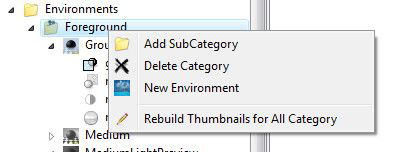 If an environment has been copied you will also be allowed to:
If an environment has been copied you will also be allowed to:
- Paste Environment
 Right clicking on a Environment allows you to:
Right clicking on a Environment allows you to:
- Copy Environment Here – adds a copy of the selected environment to the bottom of the current category.
- Delete Environment
- Rename Environment
- Copy Environment – copies the environment so it can be pasted elsewhere.
- Rebuild Thumbnail for Environment
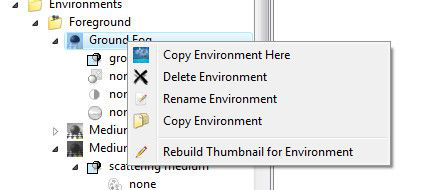 Each environment consists of four categories: Foreground (fog, light scattering, etc.), Background (clouds, planes, images, etc.), Tone (Brighten Up or Scale), and Global Environment (Cube, Panorama, etc.). These categories are found on the left side of the Render Manager and each has its own relevant parameters.
Each environment consists of four categories: Foreground (fog, light scattering, etc.), Background (clouds, planes, images, etc.), Tone (Brighten Up or Scale), and Global Environment (Cube, Panorama, etc.). These categories are found on the left side of the Render Manager and each has its own relevant parameters.  In the example above, the environment Ground Fog has two sets of parameters: Ground Fog (fog parameters) and Graduated (top and bottom colors). Other environments have different parameters.If you switch to the background environment Clouds, you can edit parameters for Clouds (color and scale of clouds).
In the example above, the environment Ground Fog has two sets of parameters: Ground Fog (fog parameters) and Graduated (top and bottom colors). Other environments have different parameters.If you switch to the background environment Clouds, you can edit parameters for Clouds (color and scale of clouds). 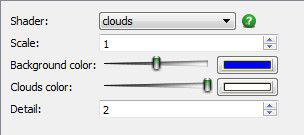 For any environment you can add set of parameters to the existing defaults. Highlight any None page and select a set of parameters from the dropdown list. In this example, you can add snow to a cloudy background.
For any environment you can add set of parameters to the existing defaults. Highlight any None page and select a set of parameters from the dropdown list. In this example, you can add snow to a cloudy background. 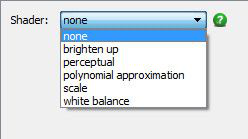 In the Preview section, you can change the shape and orientation of the preview object and desk (the surface beneath the object). Under Options, you can toggle the display of the preview object or desk. If Auto Update is checked, the preview will update each time a change is made (otherwise you must click the Preview button).
In the Preview section, you can change the shape and orientation of the preview object and desk (the surface beneath the object). Under Options, you can toggle the display of the preview object or desk. If Auto Update is checked, the preview will update each time a change is made (otherwise you must click the Preview button). 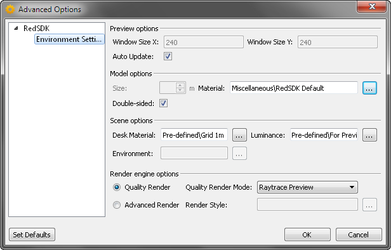 The toolbar on the right side of the editor allows you to specify the elements of the preview.
The toolbar on the right side of the editor allows you to specify the elements of the preview.  You can navigate within the preview window using the center mouse button.
You can navigate within the preview window using the center mouse button. 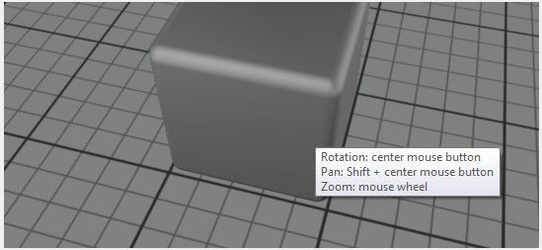
Using the Environments Palette

Default UI Menu: Tools/Palettes/Environments
Ribbon UI Menu:
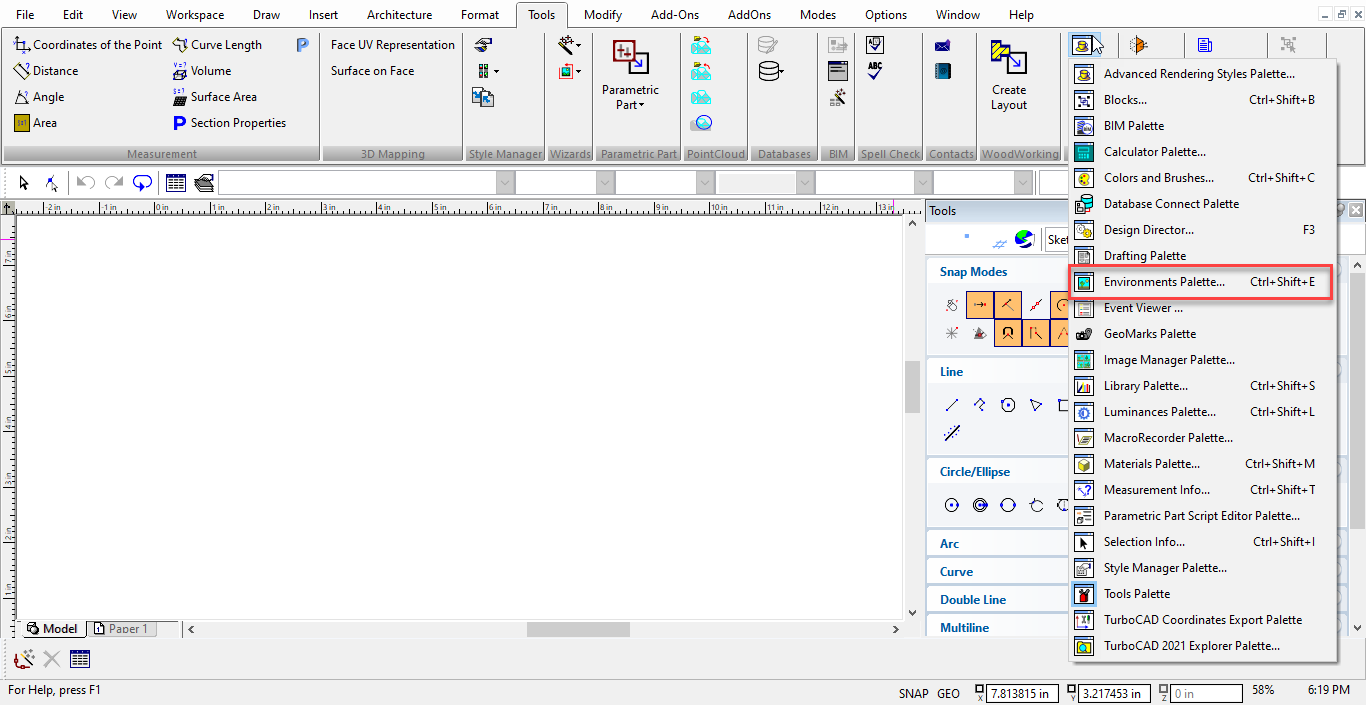
Provides easy and fast access to environments
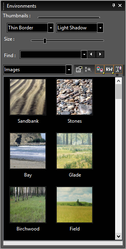 Categories
Categories 
Set the Environment category. Find Environment To switch the environment display from thumbnails to list format, click View Thumbnails and select a different view. 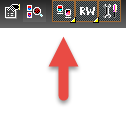 TurboCAD has LightWorks rendering engine available. The Render Engine Filter allows you to specify which components will be displayed in the palette. ALL sets the palette to show all elements from all installed rendering engines. LW will show only LightWorks elements.
TurboCAD has LightWorks rendering engine available. The Render Engine Filter allows you to specify which components will be displayed in the palette. ALL sets the palette to show all elements from all installed rendering engines. LW will show only LightWorks elements.  You can hide or show the palette fields and toolbars by clicking Show / Hide Options.
You can hide or show the palette fields and toolbars by clicking Show / Hide Options. 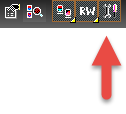 Right-click on the Environment palette will open a local menu that provides a wide array of options.
Right-click on the Environment palette will open a local menu that provides a wide array of options. 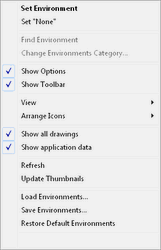 Set Environment: Sets the currently selected Environment to the currently selected objects. Set "None": Sets the Environment to none. Show Options: Toggle the display of the options on/off. Show Toolbar: Toggle the display of the toolbar on/off. View: Allows you to toggle on/off Thumbnails, List, Details Arrange Icons: Allows you to spcify how the icons will be arranged: No arrange, By Name, By Name Inversely, By Category, By Category Inversely Refresh: Refreshs the thumnails to reflect changes. Update Thumnails: regenerates all of the thumbnails in the palette. Load Environments... : Load Environments from file. Save Environments... : Saves the current Environments Remove Unassigned Environments: (This option only appears if the category is set to a Drawing Shader Manager) unused environments will be removed from the palette. Edit LightWorks Materials...: Opens the Render manager. The Render manager is opened to the current material if one is selected. If no material is selected the Render manager opens to the current category.
Set Environment: Sets the currently selected Environment to the currently selected objects. Set "None": Sets the Environment to none. Show Options: Toggle the display of the options on/off. Show Toolbar: Toggle the display of the toolbar on/off. View: Allows you to toggle on/off Thumbnails, List, Details Arrange Icons: Allows you to spcify how the icons will be arranged: No arrange, By Name, By Name Inversely, By Category, By Category Inversely Refresh: Refreshs the thumnails to reflect changes. Update Thumnails: regenerates all of the thumbnails in the palette. Load Environments... : Load Environments from file. Save Environments... : Saves the current Environments Remove Unassigned Environments: (This option only appears if the category is set to a Drawing Shader Manager) unused environments will be removed from the palette. Edit LightWorks Materials...: Opens the Render manager. The Render manager is opened to the current material if one is selected. If no material is selected the Render manager opens to the current category.
Search Option:
You can also search a environment in the palette. Type a word in "find" option to search, the first suitable item is highlighted. To browse through the environments, buttons next to the input field highlight and can be used to show the previous or next suitable item. Successful search options are added to the list and saved between sessions.
